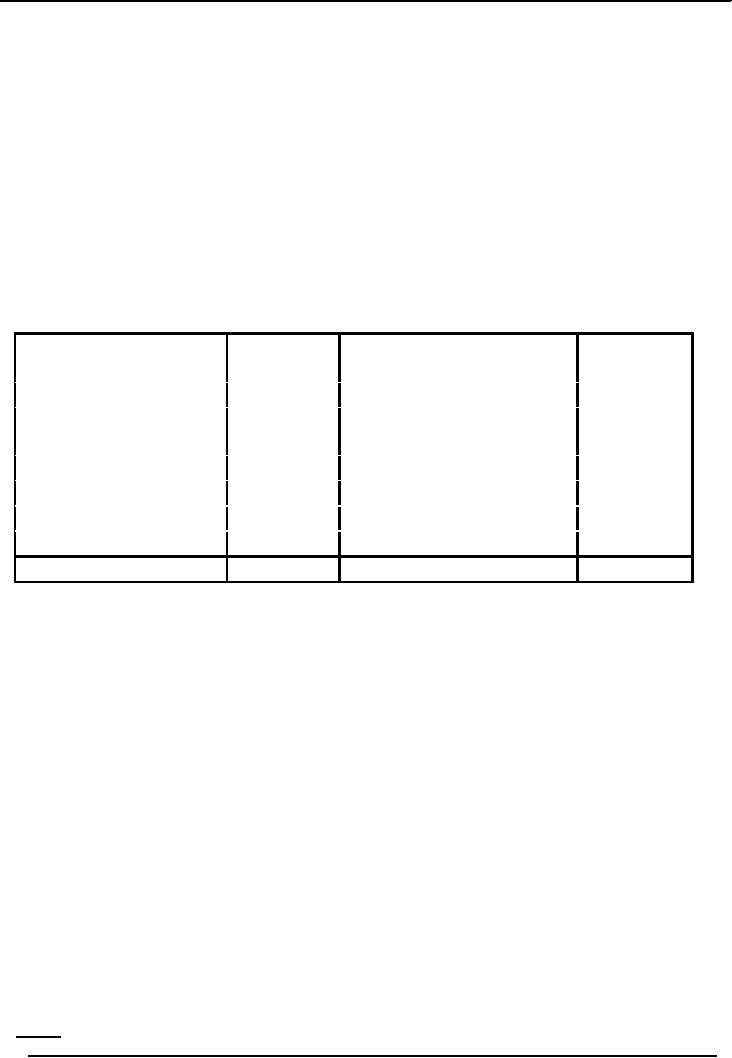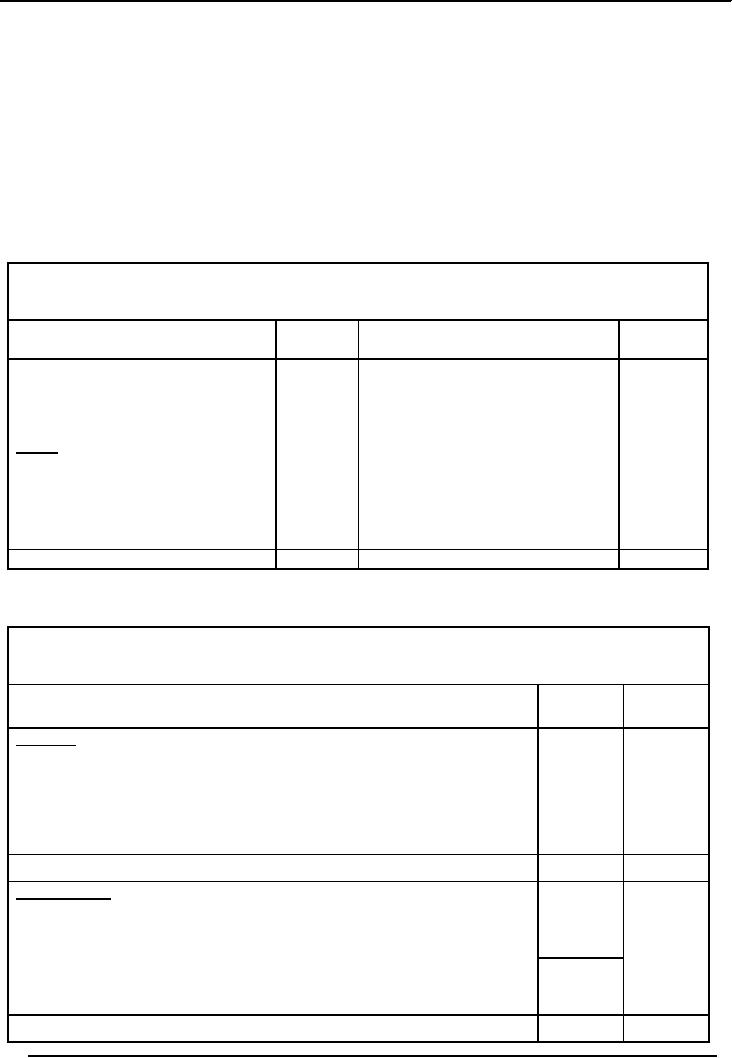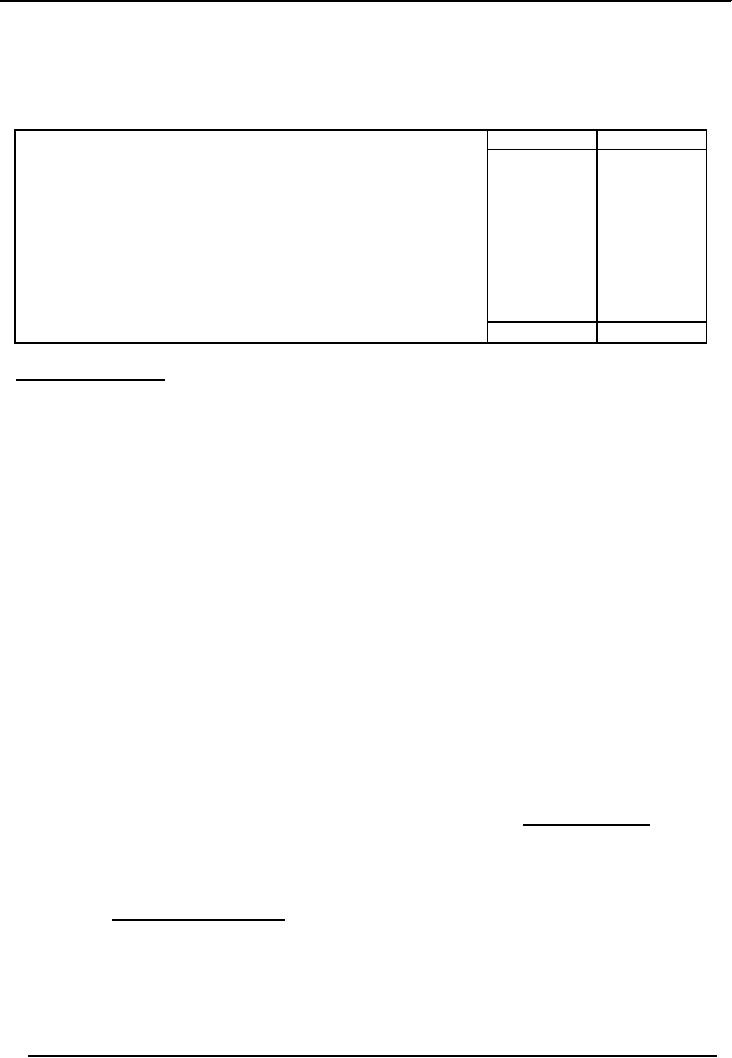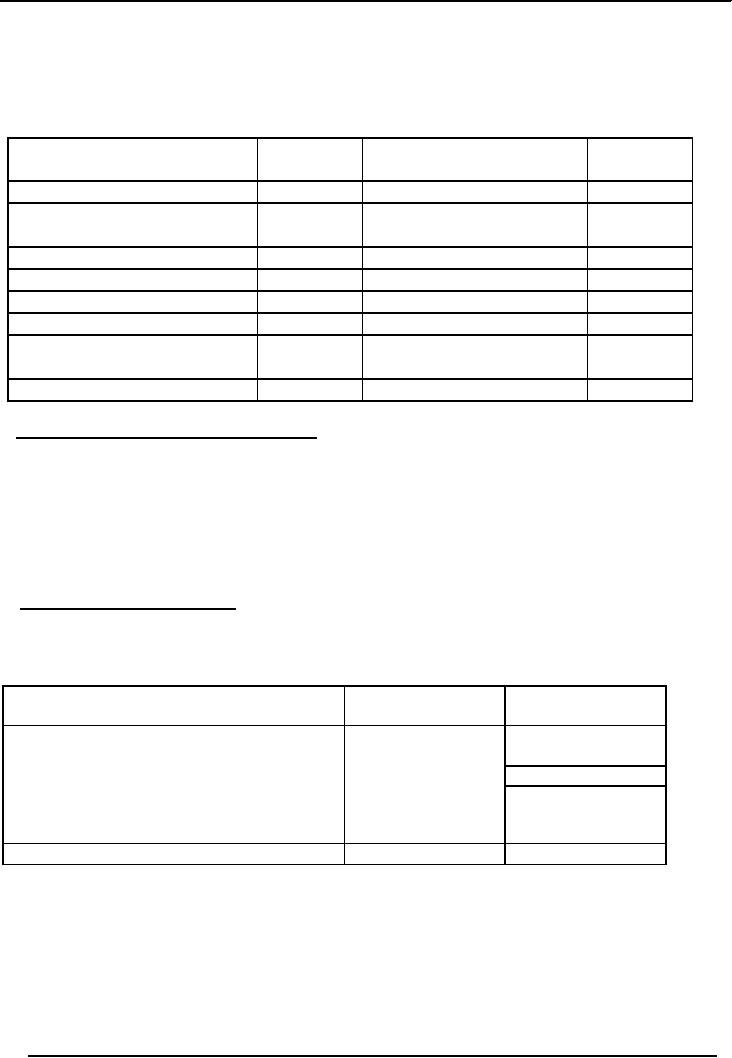 |
Preparing Balance Sheet from Trial Balance |
| << Steps in Accounting Cycle |
| Business transactions >> |

Financial
Statement Analysis-FIN621
VU
Lesson-5
ACCOUNTING
CYCLE/PROCESS
(Continued)
Preparing
Balance Sheet from Trial
Balance: We have
assumed that the first month
i.e. July was
taken
up in setting up of the business and no
business activity as such
took place in this month. It
means
there were no
Revenues & Expenses and
hence no Income Statement.
Preparing Balance Sheet
from
Trial
balance: involves re-arranging of items or
Accounts in the Trial Balance. What is
done is that
Assets
are taken on the left side
and liabilities and owner's equity on the
right. This is the Account
Form
of Balance
Sheet. Alternate form is
Report Form in which Assets
are written above and liabilities
and
owner's
equity are written
below.
Balance
Sheet
Khizr
Property dealer
For
the month of July
2006
Liabilities
& Owner's Equity
Assets
Rs.
Rs.
Cash
22,500
Accounts
Payable
23,400
Accounts
Receivable
9,500
Khizr,
Capital (owner's
equity)
180,000
Land
130,000
Building
36,000
Office
Equipment
5,400
Total
203,400
Total
203,400
It is to be
seen that each of the 7
transactions during July,
changed the Accounting Equation,
and
hence
each gave rise to new balance
sheet. The question may
arise as to why make journal
& ledger
entries.
The answer is that we have to have
reasonable time-period at the end of
which balance sheet
may
be prepared. This time-period is
Accounting Period which is
usually one year. And
during this
period
individual transactions occurring
daily are journalized and ledgerised
i.e. posted in ledgers.
Assets
are
economic resources that are
owned by a business and are expected to
benefit future
operations. In
most cases, the benefit to
future operations comes in the form of
positive future cash
flows.
The positive future cash
flows may come directly as
the asset is converted into
cash (collection of
a receivables) or
indirectly as the asset is used in
operating the business to create
other assets that
result
in
positive future cash flows
(building & land used to manufacture
a product for sale). Assets
may have
definite
physical form such as
building, machinery or stock. On the
other hand, some assets
exist not in
physical
or tangible form, but in the
form of valuable legal claims or
right. Examples are
accounts
receivables,
investment in govt. bonds and patent
rights etc.
Liabilities
are
debts and obligations of the
business. The person or
organization to which the debt
is
owed
is called creditors. All
businesses have liabilities; even the
most successful companies'
purchase
stocks,
supplies and receive services on credit.
The liabilities arising from
such purchases are
called
Accounts
payable.
Rule of
Debit and Credit for
Assets and
Liabilities
Assets
(increase
in assets is debit and
decrease in asset is
credit)
18

Financial
Statement Analysis-FIN621
VU
Liabilities
(Increase in
liability is credit and
decrease in liability is
debit)
Classification of
Assets:
There
are two types of
assets:
1. Tangible
Assets which
have physical existence and can be
seen or touched. It includes Fixed
as
well
as Current assets.
2.
Intangible assets which
have no physical existence like goodwill,
patents and s
etc.
�
Fixed
Assets Are
the assets of permanent nature that a
business acquires, such as
plant,
machinery,
building, furniture, vehicles
etc. Fixed assets are
subject to depreciation.
�
Long
Term Assets These
are the assets of the business
that are receivable after
twelve
months
of the balance sheet date.
For example, if business has
invested some money for
two
years
in any saving scheme or has
purchased saving certificates
for more than one year, it
is a
long
term asset.
�
Current
Assets Are
the receivables that are expected to be
received within one year of
the
balance
sheet date. Debtors, closing stock &
all accrued incomes are the
examples of Current
Assets
because these are expected to be
received within one accounting
period from the
balance
sheet date.
The
year, in which long term
asset is expected to be received,
long term asset is transferred
to
current
assets in that year.
Classification of
Liabilities
Capital
is the
funds invested by the owners of the
business. Business has a
liability to return
these
funds
to the owner. We know that
for the purpose of accounting,
business is treated separately from
its
owners.
This is known as Separate
Entity Concept i.e. Business is a
separate entity. Therefore, if
the
owner
gives something (can be in form of
Cash or Some other Asset) to the
business then the
business,
not
only has to return the amount to the
owner but it also has to
give some return on that
money. That is
why
we treat Capital (Owners Funds) as a
Liability.
Profit
& Loss Account The
net balance of the profit and loss
account i.e. either profit
or loss also
belongs to the
owners.
While
explaining capital we said
that the business has to
give return to the owners. Now if the
business
is
managed successfully, then this
return would be a Favorable
figure (Profit). This return
will,
therefore,
be added to the Owners'
investment.
On the
other hand, if the business is not
managed successfully then this
return would be an
un-favorable
figure
(Loss). It will, therefore, be deducted
from the Owners'
Investment.
�
Long
Term Liabilities These
are the liabilities that
will become payable after a
period of
more
than one year of the balance
sheet date. For example, if
business has taken a loan
from
bank
or any third person and it is
payable after three years, it
will be treated as a long term
liability
for the business.
�
Current
Liabilities These
are the obligations of the business
that are payable
within
twelve
months of the balance sheet date.
Creditors and all accrued
expenses are the
examples
of
current liabilities of the business
because business is expected to pay
these back within one
accounting
period.
The
year in which long term
liability is to be paid back,
long term liability is transferred
to
current
liability in that
year.
19

Financial
Statement Analysis-FIN621
VU
Balance
Sheet
It is a
position statement that
shows the standing of the
organization in Monetary Terms at a
Specific
Time.
Unlike
Profit and Loss that shows
the performance of the entity over a
period of time, the Balance
Sheet
shows
the Financial State of Affairs of the
entity at a given date. Balance
sheet is the summarized
analysis in a
`T' form of all assets
and liabilities of the entity,
with liabilities listed on
left hand side and
assets
on right hand side. Asset is any owned
physical object (tangible
asset) or a right (intangible
asset)
having
economic value to the owner. Liability is
an obligation of the business to deliver
goods or to
provide
a benefit in future.
Format
of Balance Sheet (Account
Form)
Name of
the Entity
Balance
Sheet
As
At-------
Liabilities
Amount
Assets
Amount
Rs.
Rs.
Fixes
Assets
75000
Capital
100000
Long
Term Assets
20000
115000
Add
Profit
and
loss
Account
Current
assets
80000
50000
15000
10000
Long
Term Liabilities
Current
liabilities
Total
175000
Total
175000
Format
of Balance Sheet (Report
Form)
Name of
the Entity
Balance
Sheet
As
At-------
PARTICULARS
Amount
Amount
Rs.
Rs.
ASSETS
75000
Fixes
Assets
20000
Long
Term Assets
80000
Current
Assets
Total
175000
LIABILITIES
Capital
100000
115000
Profit
15000
50000
Long
Term Liabilities
10000
Current
Liabilities
Total
175000
20

Financial
Statement Analysis-FIN621
VU
Illustration
# 1
The
following is the Trial
Balance extracted from the
books of Naeem & Sons as on
30/06/2007.
Prepare a
profit & loss account &
balance sheet for the
year ended June 30,
2007.
Particulars
Dr.
Cr.
Sales
100,000
Purchases
45,000
purchase
return
3,000
Salaries
12,000
Rent
5,000
Debtors
25,000
Creditors
16,000
Capital
368,000
Plant
& machinery
400,000
Grand
Total
487,000
487,000
Financial
Statements
�
Different
reports generated from the books of
accounts to provide information to the
relevant
persons.
�
Every
business is carried out to
make profit. If it is not
run successfully, it will sustain
loss. The
calculation
of such profit & loss is
probably the most important
objective of the accounting
function.
Such information is acquired
from "Financial Statements".
�
Financial
Statements are the end
product of the whole accounting
process. These show us
the
profitability
of the business concern and the financial
position of the entity at a specified
date.
�
The
most commonly used Financial
Statements are `profit &
loss account' `balance sheet'
&
`cash
flow statement'.
Income
& Expenditure Vs Profit & Loss
Account
�
Income
and Expenditure Account is used
for Non-Profit Organizations
like Trusts, NGOs
while
�
Profit
and Loss Account is used for
Commercial organizations like
limited companies.
Profit
& Loss Account
�
Profit
& Loss account is an account
that summarizes the profitability of the
organization for a
specific
accounting period.
�
Profit
& Loss account has two
parts:
First
part is called Trading
account in
which Gross Profit is
calculated. Gross
profit is the
o
excess
of sales over cost of goods
sold in an accounting period. In
trading concern, cost
of
goods
sold is the cost of goods
consumed plus any other
charge paid in bringing the
goods in
salable
condition. For example, if
business purchased certain items
for resale purpose and
any
expense
is paid in respect of carriage or
bringing the goods in store
(transportation charges).
These
will also be grouped under
the heading of `cost of goods
sold' and will become part
of its
price.
In manufacturing concern, cost of
goods sold comprises of
purchase of raw material
plus
wages
paid to staff employed for
converting this raw material
into finished goods plus
any other
expense
in this connection.
2nd part is called Profit
& Loss account in
which Net Profit is calculated.
Net
Profit is
what is
o
left
of the gross profit after
deducting all other expenses
of the organization in a specific
time
period.
21

Financial
Statement Analysis-FIN621
VU
How to
prepare Profit & Loss
Account?
�
One
way is to write down all the
Debit and Credit entries of Income and
Expense accounts in
the
Profit and Loss Account. But
it is not sensible to do
so.
�
The
other way is that we calculate the net
balance or we can say
Closing Balance of each
income
and expense account. Then we note
all the credit balances on the
credit side and all
the
debit
balances on the debit of profit and
loss account.
�
If the net
balance of profit and loss is
Credit (credit side is greater
than debit side) it is
Profit
and if the net
balance is Debit (Debit side
is greater than credit side) it is a
loss.
Income,
Expenditure, And Profit &
Loss
�
Income
is the
value of goods and services
earned from the operation of the
business. It includes
both
cash & credit. For
example, if a business entity
deals in garments. What it
earns from the
sale
of garments, is its income. If somebody
is rendering services, what he
earned from
rendering
services is his
income.
�
Expenses
are
the resources and the efforts
made to earn the income, translated in
monetary
terms.
It includes both expenses,
i.e., paid and to be paid
(payable). Consider the above
mentioned
example, if any sum is spent
in running the garments business
effectively or in
provision
of services, is termed as expense.
�
Profit
is the
excess of income over
expenses in a specified accounting
period.
Profit=
Income-expenses
In the above
mentioned example, if the business or the
services provider earn Rs.
100,000 & their
expenses
are Rs. 75,000. Their
profit will be Rs. 25,000
(100,000-75,000).
� Loss
is the
excess of expenses over income in a
specified period of time. In the above
example,
if
their expenses are Rs.
100,000 & their income is Rs.
75,000. Their loss will be
Rs. 25,000.
Rules
of Debit & Credit
�
Increase
in expense is Debit
(Dr.)
�
Decrease
in expense is credit
(Cr.)
�
Increase
in income is credit
(Cr.)
�
Decrease
in income is Debit
(Dr.)
Classification of
Expenses
�
It
has already been mentioned
that a separate account is opened
for each type of
expense.
Therefore,
in large business concerns, there
may be a large number of accounts
in
organization's
books
�
. As
profit & loss account is a
summarized record of the profitability of the
organization. So,
similar
accounts should be grouped
for reporting
purposes.
�
The
most commonly used groupings
of expenses are as
follows:
o Cost
of goods sold
o Administration
expenses
o Selling
expenses
o Financial
expenses
�
Cost of
goods sold (CGS) is the
cost incurred in purchasing or
manufacturing the product,
which
an organization is selling plus
any other expense incurred
in bringing the product in
saleable
condition. Cost of goods
sold contains the following heads of
accounts:
22

Financial
Statement Analysis-FIN621
VU
Purchase
of raw material/goods
o
Wages
paid to employees for manufacturing of
goods
o
Any
tax/freight is paid on
purchases
o
Any
expense incurred on
carriage/transportation of purchased
items.
o
�
Administrative
expenses are
the expenses incurred in running a
business effectively.
Main
components
of this group are:
o Payment of
utility bills
o Payment of
rent
o Salaries
of employees
o General
office expenses
o Repair
& maintenance of office equipment &
vehicles.
�
Selling
expenses are
the expenses incurred directly in
connection with the sale of goods.
This
head
contains:
o Transportation/carriage
of goods sold
o Tax/freight
paid on sale
o If the
expense head `salaries'
includes salaries of sales
staff then it will be
excluded
from
salaries & appear under the
heading of `selling expenses'.
Financial
expenses are
the interest paid on bank
loan & charges deducted by bank
on
o
entity's
bank accounts. It
includes:
Mark
up on loan
o
Bank
charges
o
Receipt
& Payment Account
A
receipt & payment account is the
summarized record of actual cash receipts
and actual cash
payment
of the
organization for a given
period of time. This is a
report that provides cash
movement during the
reported
period. In other words, it can be
defined as the summarized record of the
cash book for a
specific
period.
Receipt
& Payment Vs Profit & Loss
Account
Receipt &
payment account is the summarized record of actual
cash receipts and actual cash
o
payment
during the period while
profit & loss account
also includes Receivable and
Payable.
Income
& Expenditure Vs Profit & Loss
Account
o
These
are two similar terms.
Only difference between these
two terms is that income
&
o
expenditure
account is prepared for non
profit oriented organizations, e.g.
Trusts, NGO's,
whereas
profit & loss account is prepared in
profit oriented organizations, e.g.
Limited
companies,
Partnership firms etc.
In
case of Income and
Expenditure account, Surplus/Deficit is to be
find and in case of
Profit
o
and
loss account, profit or loss is to be
found.
23

Financial
Statement Analysis-FIN621
VU
A
sample of Profit and Loss
Account
Name of
the Entity
Profit
and Loss Account
For
the period Ending
----
DEBIT
CREDIT
PARTICULARS
AMOUNT
PARTICULARS
AMOUNT
Rs.
Rs.
Cost
of sale
60,000
Income
100,000
Gross
profit c/d
40,000
(Income
cost of sales)
Total
100,000
Total
100,000
Admin
expenses
15,000
Gross
profit b/d
40,000
Selling
expenses
5,000
Financial
expenses
5,000
Net
profit
15,000
(Gross
profit expenses)
Total
40,000
Total
40,000
Calculations of
Gross profit and Net
profit
Gross
profit = Income cost of
sales
=
100000-60000
=
40000
Net
profit = Gross profit
Expenses
=
40000 (15000+
5000+5000)
=
15000
A
sample of Income Statement
Name of
the Entity
Income
statement
For
the period Ending
----
PARTICULARS
AMOUNT
AMOUNT
Rs.
Rs
Income/Sales/Revenue
100000
Less:
Cost of sales
(60000)
Gross
profit
40000
Less:
Administration expenses
15000
Selling
expenses
5000
Financial
expenses
5000
(25000)
Net
profit
15000
Recognition
of Income and Expenditure
Account:
Income
should be recognized / recorded at the time
when goods are sold or
services are rendered.
Expenses
should be recognized / recorded when
benefit relating to that
expense has been
drawn.
Income
Statement and Net
Income
Income
Statement summarizes operating
results of a business by matching
revenues with
expenses
over the same accounting
period.
24

Financial
Statement Analysis-FIN621
VU
Net
income is the increase in owner's
equity resulting from
profitable operations of a
business.
This is accompanied by increase in total
assets, (but not necessarily
cash) or decrease in
total
liabilities.
It may happen that a profitable
business may also run short
of cash, because the profit
that it
earns
is tied up in other assets
i.e. Accounts Receivables, fixed
assets etc or else, it was
used in paying
out
its obligations like
Accounts Payable etc. Net
loss is the corresponding decrease in
owner's equity.
Elements
of Income Statement
Revenues:
This
is defined as sale price of
goods sold and services rendered
during an
accounting
period.
Expenses:
These
constitute Cost to the business of the
goods and services used in
business operations
during
the same accounting period. In
other words, these are "cost
of doing business". Just
as in
Balance
Sheet we have sub-elements or sub-Accounts, in
Income Statement also there
are sub-
elements/sub-Accounts
i.e. difference sources of
Revenues, different expenses
like cost of good
sold,
depreciation
expenses, interest expense
etc.
Accrual
Basis of Revenue & Expense
Accounting
Revenue
Recording is done on Realization
Principle. In this case, the
date of rendering
services
or date of delivery of good
sold is considered as the date of earning
revenue. For example, if
services
are rendered in January and actual
receipt of revenue/fee takes place in
February i.e. after
one
month
as per agreement, still the revenue would
be recorded in the month of January since it
was
"earned"
in January.
Expense
Recording is done on matching principle.
This means that revenues
are offset by
all
expenses incurred in producing
those revenues, pertaining to a
particular accounting period. It
would
thus
be seen that there is cause-and-effect
relationship between revenues and
expenses. For
example,
June
salaries are paid in July
but these have to be recorded as salaries
expense for June. It must
also be
noted
that Revenue & cash Receipts
and Expense & cash
payments are different. The
two can happen
before,
after or during the accounting
period.
Dr.
& Cr. Rules
for Recording Revenues and
Expenses are the same as
those for Owner's
equity
or Capital Account.
Expenses
are
the costs of the goods and services
used up in the process of earning
revenue. Examples
include
the cost of employee's salaries,
advertising, rent, utilities,
and the gradual
wearing-out
(depreciation)
of such assets as buildings,
automobiles, and office
equipment. All these costs
are
necessary
to attract and serve customers and here
by earn revenue. Expenses
are
often called the
"costs
of
doing business" that is, the cost of the
various activities necessary to
carry on a business.
An expense
always
causes a decrease
in owner's equity. The
related changes in the accounting
equation
can
be either (1) a decrease in
assets, or (2) an increase in
liabilities. An expense
reduces
assets if
payment
occurs at the time that the
expense
is
incurred. If the expense
will
not be paid until later, as
for
example,
the purchase of advertising services on
account, the recording of the expense
will be
accompanied
by an increase in liabilities.
25
Table of Contents:
- ACCOUNTING & ACCOUNTING PRINCIPLES
- Dual Aspect of Transactions
- Rules of Debit and Credit
- Steps in Accounting Cycle
- Preparing Balance Sheet from Trial Balance
- Business transactions
- Adjusting Entry to record Expenses on Fixed Assets
- Preparing Financial Statements
- Closing entries in Accounting Cycle
- Income Statement
- Balance Sheet
- Cash Flow Statement
- Preparing Cash Flows
- Additional Information (AI)
- Cash flow from Operating Activities
- Operating Activities’ portion of cash flow statement
- Cash flow from financing Activities
- Notes to Financial Statements
- Charging Costs of Inventory to Income Statement
- First-in-First - out (FIFO), Last-in-First-Out (LIFO)
- Depreciation Accounting Policies
- Accelerated-Depreciation method
- Auditor’s Report, Opinion, Certificate
- Management Discussion & Analyses (MD&A)
- TYPES OF BUSINESS ORGANIZATIONS
- Incorporation of business
- Authorized Share Capital, Issued Share Capital
- Book Values of equity, share
- SUMMARY
- SUMMARY
- Analysis of income statement and balance sheet:
- COMMON –SIZE AND INDEX ANALYSIS
- ANALYSIS BY RATIOS
- ACTIVITY RATIOS
- Liquidity of Receivables
- LEVERAGE, DEBT RATIOS
- PROFITABILITY RATIOS
- Analysis by Preferred Stockholders
- Efficiency of operating cycle, process
- STOCKHOLDERS’ EQUITY SECTION OF THE BALANCE SHEET 1
- STOCKHOLDERS’ EQUITY SECTION OF THE BALANCE SHEET 2
- BALANCE SHEET AND INCOME STATEMENT RATIOS
- Financial Consultation Case Study
- ANALYSIS OF BALANCE SHEET & INCOME STATEMENT
- SUMMARY OF FINDGINS